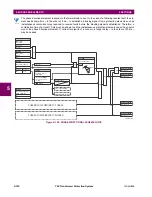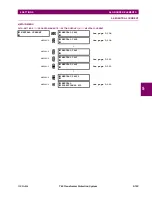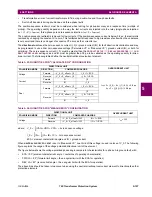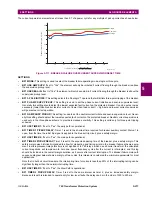
5-206
T60 Transformer Protection System
GE Multilin
5.6 GROUPED ELEMENTS
5 SETTINGS
5
(EQ 5.41)
The equation above brings an advantage of generating the restraining signal of twice the external ground fault current,
while reducing the restraint below the internal ground fault current. The negative-sequence component of the restraining
signal (IR2) is meant to provide maximum restraint during external phase-to-phase faults and is calculated as follows:
(EQ 5.42)
The multiplier of 1 is used by the relay for first two cycles following complete de-energization of the winding (all three phase
currents below 5% of nominal for at least five cycles). The multiplier of 3 is used during normal operation; that is, two cycles
after the winding has been energized. The lower multiplier is used to ensure better sensitivity when energizing a faulty
winding.
The positive-sequence component of the restraining signal (IR1) is meant to provide restraint during symmetrical condi-
tions, either symmetrical faults or load, and is calculated according to the following algorithm:
1 If
of phase CT, then
2
If ,
then
3
else
4 else
Under load-level currents (below 150% of nominal), the positive-sequence restraint is set to 1/8th of the positive-sequence
current (line 4). This is to ensure maximum sensitivity during low-current faults under full load conditions. Under fault-level
currents (above 150% of nominal), the positive-sequence restraint is removed if the zero-sequence component is greater
than the positive-sequence (line 3), or set at the net difference of the two (line 2).
The raw restraining signal (Irest) is further post-filtered for better performance during external faults with heavy CT satura-
tion and for better switch-off transient control:
(EQ 5.43)
where k represents a present sample, k – 1 represents the previous sample, and
α
is a factory constant (
α <
1). The equa-
tion above introduces a decaying memory to the restraining signal. Should the raw restraining signal (Irest) disappear or
drop significantly, such as when an external fault gets cleared or a CT saturates heavily, the actual restraining signal (Igr(k))
will not reduce instantly but will keep decaying decreasing its value by 50% each 15.5 power system cycles.
Having the differential and restraining signals developed, the element applies a single slope differential characteristic with a
minimum pickup as shown in the logic diagram below.
Figure 5–109: RESTRICTED GROUND FAULT SCHEME LOGIC
IR0
IG IN
–
IG
IA IB IC
+
+
(
)
–
=
=
IR2
I_2
=
or IR2
3
I_2
×
=
I_1
2 pu
>
I_1
I_0
>
IR1
3
I_1
I_0
–
(
)
×
=
IR1
0
=
IR1
I_1 8
⁄
=
Igr k
( )
max Irest k
( ) α
Igr k 1
–
(
)
×
,
(
)
=
SETTING
SETTING
SETTING
SETTING
SETTINGS
SETTING
FLEXLOGIC OPERANDS
ACTUAL VALUES
RESTD GND FT1
FUNCTION:
RESTD GND FT1
BLOCK:
RESTD GND FT1
SOURCE:
RESTD GND FT1
PICKUP:
RESTD GND FT1 RESET
DELAY:
RESTD GND FT1 PICKUP
DELAY:
RESTD GND FT1
SLOPE:
RESTD GND FT1 OP
RESTD GND FT1 DPO
RESTD GND FT1 PKP
RGF 1 gd Mag
I
RGF 1 gr Mag
I
Off=0
Enabled=1
Disabled=0
AND
828002A2.CDR
RUN
RUN
I
gd > PICKUP
I
N
I
G
I
_0
I
_1
I
_2
AND
> SLOPE *
I
gd
I
gr
Differential
and
Restraining
Currents
tPKP
tRST
Summary of Contents for UR T60
Page 10: ...x T60 Transformer Protection System GE Multilin TABLE OF CONTENTS ...
Page 14: ...xiv T60 Transformer Protection System GE Multilin 0 1 BATTERY DISPOSAL 0 BATTERY DISPOSAL 0 ...
Page 34: ...1 20 T60 Transformer Protection System GE Multilin 1 5 USING THE RELAY 1 GETTING STARTED 1 ...
Page 436: ...5 298 T60 Transformer Protection System GE Multilin 5 10 TESTING 5 SETTINGS 5 ...
Page 678: ...C 30 T60 Transformer Protection System GE Multilin C 7 LOGICAL NODES APPENDIX C C ...
Page 688: ...D 10 T60 Transformer Protection System GE Multilin D 1 IEC 60870 5 104 PROTOCOL APPENDIX D D ...
Page 700: ...E 12 T60 Transformer Protection System GE Multilin E 2 DNP POINT LISTS APPENDIX E E ...






























